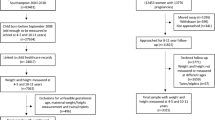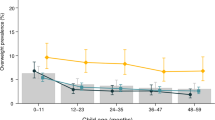Abstract
BACKGROUND: Obesity is an increasing problem so understanding the association between childhood and adolescent measures of body mass index (BMI) and being overweight at age 21 has implications for treatment or strategies to reduce its prevalence.
OBJECTIVE: To examine the association between measures of BMI in childhood and adolescence and parents' BMI and being overweight at age 21.
DESIGN: The study was based on a birth cohort born in Dunedin, New Zealand in 1972–1973.
RESULTS: BMI tracked from childhood to early adulthood. The point on the BMI distribution where the probability of being overweight at age 21 was 0.5 was close to the 75th centile for boys throughout childhood and adolescence. It was rather higher for girls in childhood but similar in adolescence. Boys with a BMI above the 75th centile at age 7 were more than 4.0 times more likely to be overweight at age 21 than those with a BMI below the median. The relative risk for girls was 3.2. By age 15 this increased to 9.8 for males and 6.8 for females. Having overweight parents, particularly a mother, increased the likelihood of being overweight. Only 40% of those who were overweight at age 21 could be identified by age 7 and 25% were not identified until they were at least 15.
CONCLUSION: Although a high BMI in childhood predicts being overweight at age 21, many of those who were overweight at age 21 had a BMI below the 75th centile or even the median in childhood and early adolescence. Population strategies, complemented by an individual approach for those above the 75th centile, are needed to reduce the average BMI of the population.
This is a preview of subscription content, access via your institution
Access options
Subscribe to this journal
Receive 12 print issues and online access
$259.00 per year
only $21.58 per issue
Buy this article
- Purchase on Springer Link
- Instant access to full article PDF
Prices may be subject to local taxes which are calculated during checkout
Similar content being viewed by others
References
Must A, Strauss RS . Risks and consequences of childhood and adolescent obesity Int J Obes Relat Metab Disord 1999 23 (Suppl 2): S2–S11.
Must A, Jacques PF, Dallal GE, Bajema CJ, Deitz WH . Long-term morbidity and mortality of overweight adolescents New Engl J Med 1992 327: 1350–1355.
Dietz W . How to tackle the problem early? The role of education in the prevention of obesity Int J Obes Relat Metab Disord 1999 23 (Suppl): S4–S9.
WHO Obesity: preventing and managing the global epidemic Report of a WHO consultation on Obesity WHO: Geneva 1998.
Silva PA, Stanton WR, (eds) . From Child to Adult The Dunedin Multidisciplinary Health and Development Study Oxford University Press: Auckland 1996.
Cole TJ . Growth charts for both cross-sectional and longitudinal data Stat Med 1994 13: 2477–2492.
Cole TJ, Freeman JV, Preece MA . Body mass index reference curves for the UK, 1990 Arch Dis Child 1995 73: 25–29.
Williams S . Body mass index growth curves for use in New Zealand NZ Med J 2000 113: 308–311.
Zhang J, Yu KF . What's the relative risk? A method of correcting odds ratios in cohort studies of common outcomes JAMA 1998 280: 1690–1691.
Valdez R, Greenland KJ, Wattigney WA, Boa W, Berenson GS . Use of weight-for-height indices in children to predict adult overweight: the Bogulsa Heart Study Int J Obes Relat Metab Disord 1996 20: 715–720.
Lauer RM, Lee J, Clarke WR . Factors affecting the relationship between childhood and adult cholesterol levels: the Muscatine study Pediatrics 1988 82: 309–318.
Power C, Lake JK, Cole TJ . Body mass index and height from childhood to adulthood in the 1958 British birth cohort Am J Clin Nutr 1997 66: 1094–1101.
Serdula MK, Ivery D, Coates RJ, Freedman DS, Williamson DF, Byers T . Do obese children become obese adults? A review of the literature Prev Med 1993 22: 167–177.
Guo SS, Roche AF, Chumlea WC, Gardner JD, Siervogel RM . The predictive value of childhood body mass index values for overweight at age 35 y Am J Clin Nutr 1994 59: 810–819.
Dietz WH . Use of body mass index (BMI) as a measure of overweight in children and adolescents J Pediat 1998 132: 191–193.
Lake JK, Power C, Cole TJ . Child to adult body mass index in the 1958 British birth cohort: associations with parental obesity Arch Dis Child 1997 77: 376–381.
Whitaker RC, Wright JA, Pepe MS, Seidel KD, Dietz WH . Predicting obesity in young adulthood from childhood and parental obesity New Engl J Med 1997 337: 869–873.
Mann JI, Nye ER, Wilson BD, Russell D, Wilson N, Herbison P . Life in New Zealand Commission Report, Volume V: Health University of Otago: Dunedin 1991.
Bost L, Primatesta P, Dong W . Anthropometric measures and children's iron status. In: Health Survey for England 1996 Ministry of Health: London 1998.
Acknowledgements
Thanks are due to Dr Ailsa Goulding, Professor Jim Mann and Dr Richie Poulton, who read and commented on this paper. The Dunedin Multidisciplinary Research and Development Unit and the author are supported by the Health Research Council of New Zealand. The author would like to acknowledge the support of Dr Phil Silva, former director of the study, those who collected the data and the participants.
Author information
Authors and Affiliations
Corresponding author
Rights and permissions
About this article
Cite this article
Williams, S. Overweight at age 21: the association with body mass index in childhood and adolescence and parents' body mass index. A cohort study of New Zealanders born in 1972–1973. Int J Obes 25, 158–163 (2001). https://doi.org/10.1038/sj.ijo.0801512
Received:
Revised:
Accepted:
Published:
Issue Date:
DOI: https://doi.org/10.1038/sj.ijo.0801512
Keywords
This article is cited by
-
Associations of overweight and obesity with cardiometabolic risk factor clusters among Korean adolescents
Scientific Reports (2024)
-
The dangerous link between childhood and adulthood predictors of obesity and metabolic syndrome
Internal and Emergency Medicine (2016)
-
BMI at 4 years of age is associated with previous and current protein intake and with paternal BMI
European Journal of Clinical Nutrition (2010)
-
Preventing Excessive Weight Gain in Adolescents: Interpersonal Psychotherapy for Binge Eating
Obesity (2007)
-
Parent Overweight Predicts Daughters’ Increase in BMI and Disinhibited Overeating from 5 to 13 Years
Obesity (2007)



